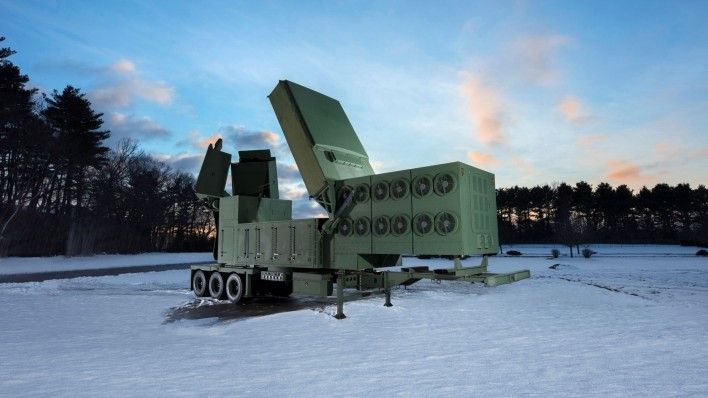Polish MoD Unveils Air Force Modernization Plan. Over USD 30 billion to be spent on Integrated Air and Missile Defence

Parliamentary National Defence Commission assembled to discuss the information provided by the Minister of Defence, concerning the status of the Polish Air Force, its mission readiness, and the planned steps in modernization. A lot of concrete data was released during the debate, including the number of combat-capable F-16 jets, or delivery dates and HEAD operations start date associated with the Boeing 737s. The Polish MoD also outlined the amounts involved and timelines regarding the programmes that concern both the Air Force, as well as other branches of the military - including procurement of UAS and air defence systems.
The meeting began with a statement by the undersecretary at the Polish Ministry of Defence, Wojciech Skurkiewicz, who presented the information that the Polish MoD provided. As stated by Skurkiewicz, the Polish combat aviation component utilizes 48 F-16 aircraft spread among three squadrons. Another three squadrons: a single Su-22 unit, and two MiG-29 elements; are used solely in peacetime. MiG-29 jets are also deployed to conduct air policing missions, in the Baltics, and in Poland as well. In case of war, the Soviet-made aircraft would be virtually useless. Responding to the questions asked by the MPs, regarding the number of aircraft capable of undertaking operational activities, Skurkiewicz also provided definitive numbers. 41 out of 48 F-16s exhibit full combat capability - this is a number that is higher than the one we obtained last year (a bit over 30 airframes translating into around 60% of availability). The above means that the operational readiness of the Polish F-16 fleet now exceeds 80%. On one hand, this is a significantly high value, exceeding the analogous indicator in the USAF (around 70%).
On the other hand, though, readiness as such is a must, considering the limited overall number of aircraft remaining in the inventory of the Polish Air Force. Skurkiewicz also noted that 28 MiG-29s and 18 Su-22s are also being operated by the service, without any details referring to the availability. Responding to safety concerns raised by the MPs, when it comes to the Fulcrums, amidst the failures and crashes of the recent years, a statement was made by the Air Force Inspector, Div. Gen. Jacek Pszczoła. He said that the Bydgoszcz-based WZL facility has learned its painful lesson, and now it is trusted by both him and the pilots, with the safety levels being satisfactory.
Skurkiewicz announced that Harpia programme aimed at the acquisition of 32 F-35As along with a training and logistics package is currently underway. The acquisition itself is to have a price tag of around PLN 20 bn. If the infrastructure and armament-related investments are taken into the equation, the amount would be as high as 28.6 bn zlotys (7,5 USD billion).
Responding to a question asked by Maciej Lasek (KO MP), referring to the plans of withdrawal with regard to MiG-29 and Su-22, Skurkiewicz said that the Su-22 Fitters would be decommissioned in 2025, while the withdrawal process regarding the MiG-29 would progress gradually, along with the F-35 deliveries. MP Mroczek raised a concern that there is no plan in place, regarding the new structure of the Air Force. Responding to that, General Pszczoła said that by 2030 the Polish Air Force is to consist of five complete squadrons, 16 airframes in each squadron.
This, however, is not exhaustive. “In the back of my head, I believe that Harpia programme would result in the procurement of 4 squadrons, ultimately. It is not my place to say as to what type of aircraft would be procured next, but by 2035 another two squadrons would exist. Seven squadrons, 16 aircraft in each, by 2035”, Pszczoła said. Skurkiewicz also said that, depending on the finances, a decision to procure more combat aircraft after 2035 may be made. The official noted that the F-35 acquisition is a long-term investment, with the platform acting as a “domain integrator” boosting the capabilities of the Polish defence system. It is expected that they would be able to serve until the year 2070.
Skurkiewicz also outlined the status of the Polish airlift assets, with that component currently operating 59 aircraft, including 39 Bryzas (PZL Mielec M28), 16 C296Ms, 5 C-130 Hercules, 2 Gulfstream G550s, and a single Boeing 737-800. A procedure is underway, to procure five second-hand C-130H airframes, within the framework of EDA.
The MPs were also asking questions regarding the date of delivery of the two remaining Boeing airframes that have been already ordered. Pszczoła said that following the delays related to retrofitting of the aircraft in France, and delays resulting on the grounds of the pandemic, the aircraft in question will be arriving in Poland soon. The first one is expected to arrive in May, while the second - in June this year. Both are also expected to gain operational readiness in July. Pszczoła also announced that the sole Boeing aircraft delivered until today (“Józef Piłsudski”) would then leave for Toulouse on 21st June for retrofitting. The retrofitted airframe would come back to Warsaw in December. Representatives of the MoD also noted that three crews per aircraft have been trained to carry out VIP flights.
Within the context of the VIP aircraft, a dispute emerged regarding the procurement process of those. Czesław Mroczek indicated that an amount of 1.7 bn zlotys had been allocated to that acquisition earlier, while 3.05 bn. was the actual price paid for them, during the term of office of Macierewicz and Kownacki. Grabarczyk MP (KO) also pointed out that the acquisition was subjected to critique by the Supreme Chamber of Control. Bartosz Kownacki responded, stating that the Boeings, at the time of the acquisition, were the only aircraft meeting the Polish requirements defined for the VIP transport platforms. Kownacki said that the former government, allocating just PLN 1.7 bn. zlotys to the acquisition in question was unreasonable. Leasing of the Embraer airliners from Lot Polish Airlines was referred to, by Kownacki, as a waste. Kownacki added that no respectable government transports VIPs onboard aircraft that belong to the class of those leased by the Polish state. A similar opinion was voiced by MP Rozenek (SLD), stating that the matter shall be looked at in an objective manner. “The Polish state stopped using half-measures, and we are witnessing positive results. Critique directed against this procurement is not understandable to me”, he said.
The discussion was also quite intense when it came to helicopters. Skurkiewicz informed that the Polish military currently operates 238 rotary-wing aircraft, including 68 W-3, 22 SW-4, 58 Mi-2, 25 Mi-8, 19 Mi-17, 10 Mi-14, 4 SH-2H, 28 Mi-24, and 4 Black Hawks.
He also said that 4 ASW/SAR AW101 helicopters were procured. Black Hawks, meanwhile, are undergoing retrofitting to meet the requirements of the user, namely the SOF component. The process of retrofitting is expected to be finalized by the end of this year. 4 W-3 Sokół SAR platforms, meanwhile, are being upgraded to a common W-3WA SAR/FADEC standard. The first two aircraft would be handed off in July this year, with another two to follow in October 2022. Before that, similar upgrades had been implemented on 8 Sokół helicopters, it is expected that 20 would undergo similar upgrades. All of those would be received by the 1st and 2nd SAR (ASAR) Groups and the 33rd Airlift Base. Kondor naval helicopter procurement procedure and Kruk attack helicopter acquisition are in progress as well. As for now, the Technical Modernization Plan envisages allocation of an amount of PLN 16.2 bn. to the upgrades of the helicopter fleet.
During the meeting, another discussion took place referring to the resignation from the acquisition of the 50 Caracal helicopters.
Skurkiewicz also outlined the status of the training component in the Air Force. Currently, it comprises 52 aircraft: 28 PZL-130 Orlik (some of which are undergoing TC-II Advanced upgrades), eight M-346 Bielik AJTs (another four have arrived and are going through the handing-off procedure), 8 TS-11 Iskra trainers, 8 Bryza aircraft, and 33 SW-4 and Mi-2 helicopters, plus a simulator center at the 41st Training Aviation Base in Dęblin. Bryza, Mi-2, and SW-4 aircraft were all included in the previously quoted status reports regarding the airlift and helicopter assets. Implementation of a programme aimed at establishing infrastructure for the M-346 is underway now.
When it comes to the UAVs, the Minister mentioned the 12th Base in Mirosławiec operating 15 Mini Orbiter 2B elements. Procurement procedures are in progress, regarding the acquisition of the tactical short range UAVs (Orlik), 15 medium-range tactical Gryf UAVs, and four MALE UAVs (Zefir). Col. Waldemar Bogusławski, speaking on behalf of the Armament Inspectorate, added that two agreements are being drafted now, regarding the micro-UAVs and the Orlik programme. The mini-UAV procurement procedure is also being carried out now (Wizjer). Furthermore, the MoD also launched an acquisition programme regarding the Albatros naval UAV platforms.
The opposition MPs were indicating that the UAV procurement plans are insufficient, taking into account the recent experiences of the Armenia/Azerbaijan conflict and the global trends in the development of assets as such.
Information pertaining to the plans related to UAV procurement presented by the MoD (and the information regarding the air defence assets outlined below), most probably refers to the Air Force, and other branches of the military as well (Land Forces, receiving the Poprad SHORAD systems, or the Navy, expected to receive the Albatros systems).
Skurkiewicz also addressed the air defence assets issues. Currently, Wisła air/missile defence system, Narew SHORAD system, Pilica AAA/SAM system, Poprad VSHORAD system, Piorun MANPADS system, SONA AAA system, Noteć AAA system, Nida aerial counter-UAS system, Bystra radars, and Grzmot short-range missile system proceedings are underway in that domain. Together, the aforesaid tasks have a value of 122.6 bn. zlotys (over 32 USD billion), as defined within the Technical Modernization Plan.
Modernization of the radio-technical component’s inventory is also going on. NUR-31 and NUR-41 radars are bound to be replaced by new, domestically developed NUR-15M systems (15 examples). A project also has been launched to develop a domestic long-range radar (known as Warta - 17 radars to be acquired). Finally, the military also plans to procure 15 ATC radars, within the framework of a project named Drawa. To lower the level of the radar coverage in the East, four Aerostat-based radars would be acquired. The procurement programme is codenamed Barbara, when it comes to these assets.
